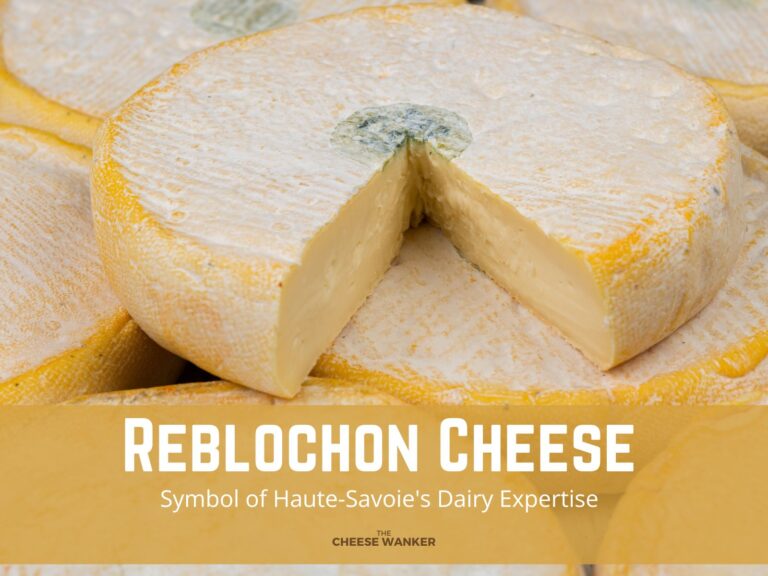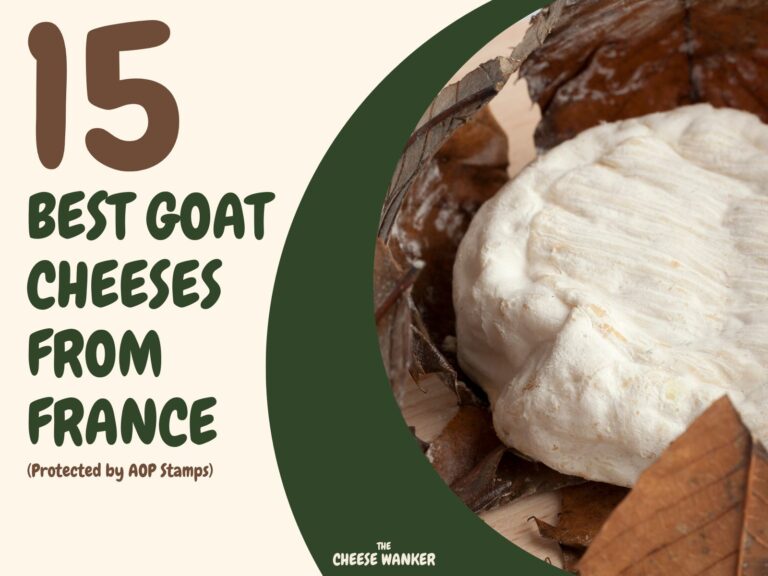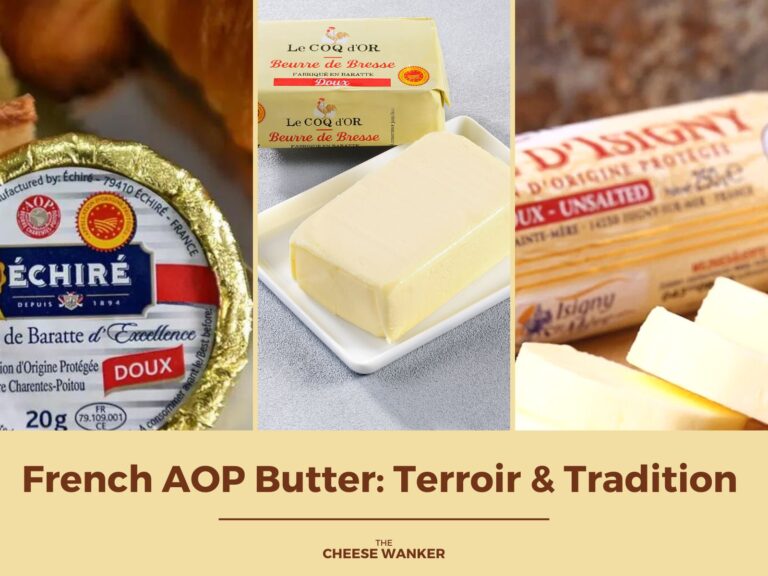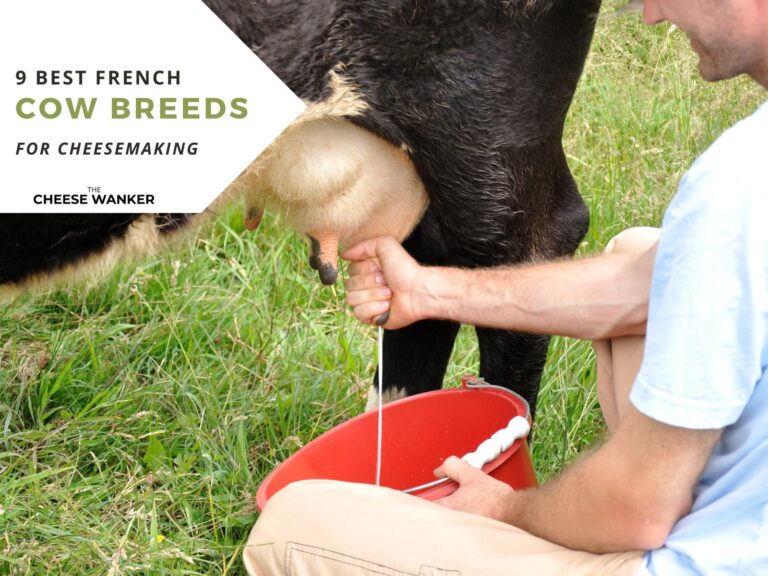There are few cheeses from anywhere around the world that generate as much hype and passion as Mont d’Or. Read on to learn more about this iconic seasonal French mountain cheese. In this post, we will cover the history, production and tasting notes for the Holy Grail of cheese.
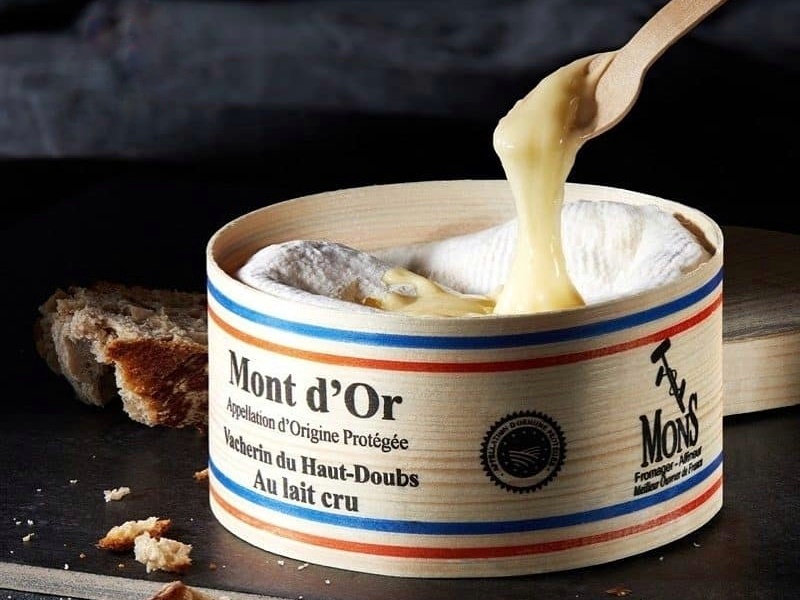
SEE ALSO: Why are some cheeses wrapped in spruce bark? →
What is Mont d’Or?
Also known as Vacherin du Haut-Doubs, Mont d’Or is a seasonal soft washed rind cheese that is made above 700m in the Haut-Doubs region of France. Since 1996, it has been protected by an AOP stamp which regulates its production and maturation. This historic cheese (early mentions date to the year 1280) is exclusively made from raw cow’s milk from the 15th of August to the 15th of March each year.
The story behind the name Vacherin du Haut-Doubs is indeed an interesting one. Back in the day, Vacherin was the cheese of vachers. And a vacher is someone who rears and/or herds cattle in the Jura mountains.
As for Mont d’Or, it is a reference to the eponymous mountain in the Haut-Doubs region. Its name can be translated to Golden Mountain in English.
The history of Mont d’Or
Quite remarkably, the earliest mentions of this beautiful cheese date back to the late 13th century. While they don’t mention the cheese by name, records from those time describe a soft washed rind cheese that is wrapped in bark. Fast forward to the 18th century and Mont d’Or had made its way to King Louis XV’s table.
Historically, the vachers would use their rich winter milk to make Mont d’Or. In the Jura mountains, cheesemakers almost exclusively use spring and summer milk for Comté production. In winter, the cows produce less milk and access to cheesemaking facilities was tricky because of the weather.
Hence, farmers started to make smaller cheeses for their own personal consumption during the festive season. Over time, the popularity of Mont d’Or has meant that its season has expanded to range from the 10th of September to the 10th of May (depending on stock levels).
In 1981, Mont d’Or attained AOC status to protect its terroir, production methods and geographical origin. As the European Union formed, its stamp of protection expanded to include an AOP in 1996.
Who makes Mont d’Or?
Presently, there are only 10 cheesemakers who make Mont d’Or. Some of the more famous ones are Fromagerie Badoz, Coopérative Fromagère de Doubs and Fromagerie du Mont d’Or Sancey-Richard. Among the 10 producers, only La Ferme Mamet make a farmhouse Mont d’Or on their own farm using the milk from their herd of cows.
Between them, the 10 producers make about 5500 metric tonnes of cheese every year. And they source their milk from 400 local farmers. The AOP has strict animal welfare requirements in place. As a matter of fact, each dairy cow needs to have access to 1 hectare of pasture.
How is Mont d’Or made?
As you can expect, there are very strict guidelines in place for the production of Mont d’Or. You can learn about the entire process by clicking here.
Raw cow’s milk
As always, it starts with the milk. The AOP dictates that Mont d’Or makers have to use raw whole cow’s milk. Moreover, the cheesemakers cannot heat treat their milk in any way and have to start cheese production within 24 hours of milking.
Traditional production methods
Production of Mont d’Or gets under way with coagulation of the milk at 39°C and the addition of rennet. Once the curd is formed, the cheesemaker cuts it into hazelnut-sized pieces and hoops them into cylindrical moulds for pressing.
Wrapped in spruce
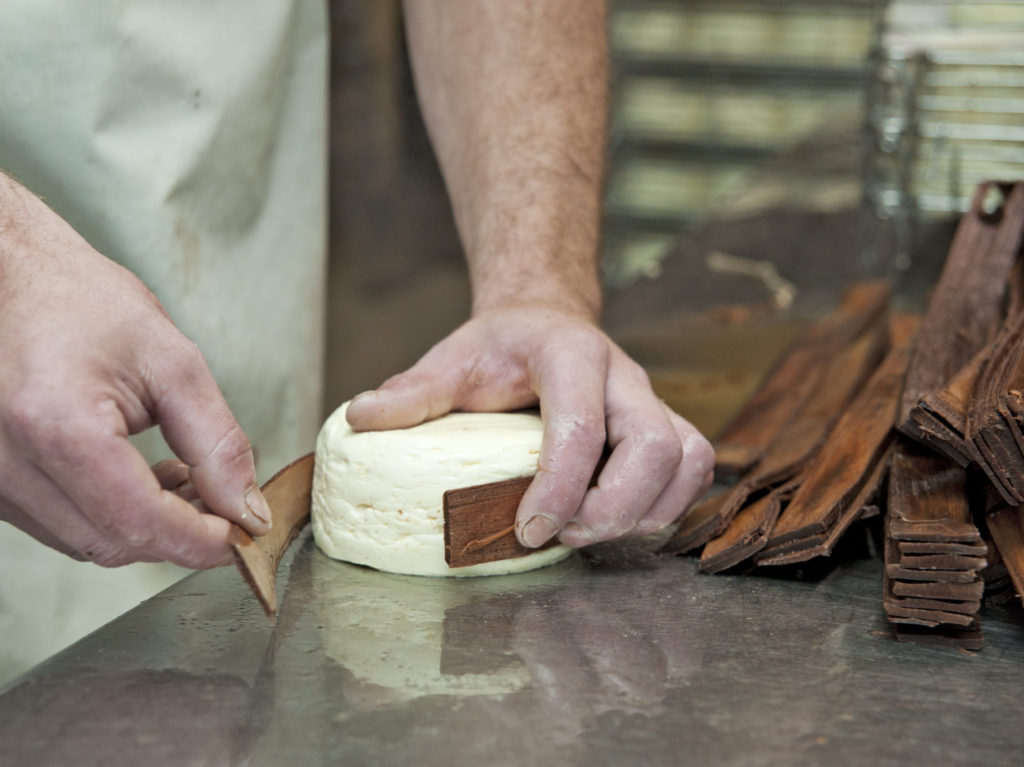
After pressing, they remove the young cheese from its mould and wrap them in a spruce bark by hand. The spruce bark is an essential part of the identity of Mont d’Or and makes a significant contribution to the aroma and flavour of the cheese.
Currently, a small number of sangliers produce the spruce bark wraps for Mont d’Or. The bark has an iconic pliable texture and a woody aroma. Overall, each Mont d’Or cheese spends a minimum of 21 days on spruce planks to mature. During this time, an affineur regularly brushes and turns them.
How is Mont d’Or packaged?
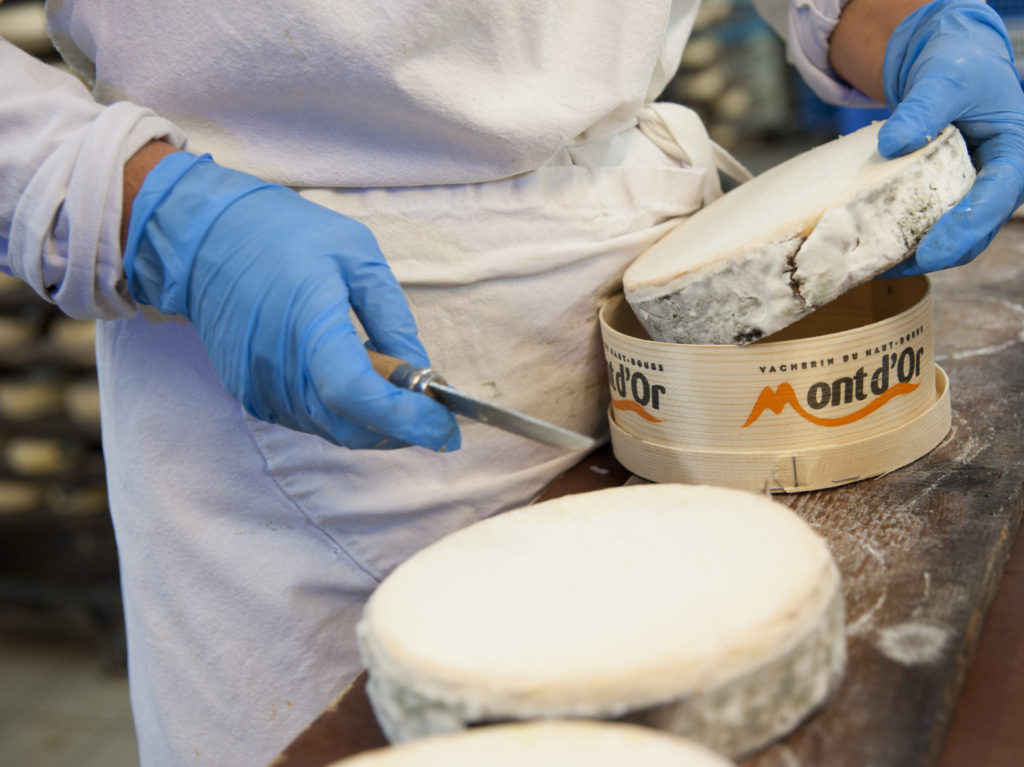
From day 12, the cheesemaker transfers the cheese into a spruce box that is just a little bit smaller than the cheese itself. Because the cheese has to be squeezed in, it develops delicate ripples on its top surface which are reminiscent of the mountain landscape of the Haut-Doubs.
Presently, there are only four manufacturers who make the box for Mont d’Or. They all use spruce bark from freshly cut trees. And they deliver the boxes promptly to the cheesemakers to preserve their woody aroma and texture.
What does Mont d’Or taste like?
The end result is a soft cheese with a woody, earthy aroma. Overall, it has a full, rich, sweet and grassy flavour with a slightly acidic finish. Because of its unique aroma and flavour, Mont d’Or is one of the most sought-after cheeses in the entire world.
The locals eagerly await its release every year in September. And it brings in hordes of tourists to the Haut-Doubs region.
How do the French serve Mont d’Or?
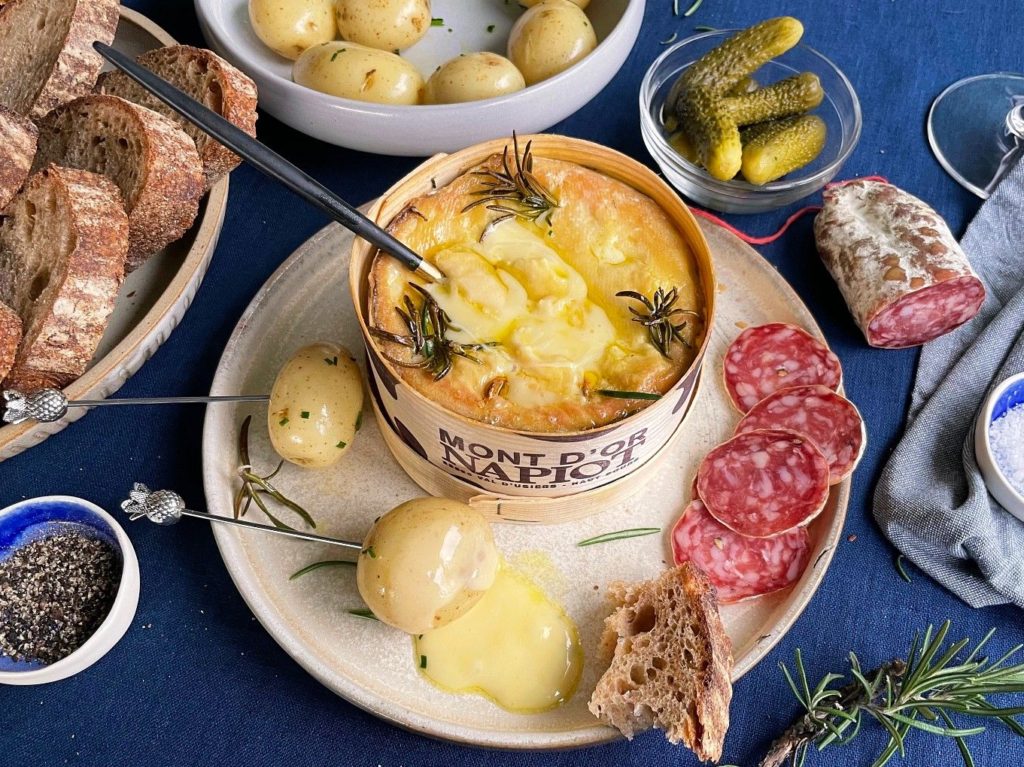
When ripe, Mont d’Or can be served at room temperature. The best way to enjoy this seasonal cheese is by cutting the rind off the top and dipping a wooden spoon into the oozy, creamy paste underneath. Then, you will want to generously spread your bounty on a warm, crunchy baguette.
Having said that, you can also bake Mont d’Or in its original wooden box. Gently poke in some garlic shards and add a splash of local white wine before sticking it in the oven. Finally, you can serve this little piece of heaven with Jura ham, sausages and boiled potatoes.
Mont d’Or FAQs
Is Mont d’Or available in the USA?
Because it is made with raw milk and matured for less than 4 weeks, Mont d’Or is banned in a number of countries around the world, including the USA and Australia. You can however get your hands on the pasteurised or thermalised versions.
I thought Vacherin was a Swiss cheese
Indeed, there are two Swiss versions called Vacherin Mont d’Or and Vacherin Fribourgeois. The Swiss Vacherin Mont d’Or is made with thermalised milk. And Vacherin Fribourgeois is actually a very different type of cheese. To this day, the French and the Swiss still argue over who created Vacherin first!
What cheeses are similar to Mont d’Or?
Other than the Swiss Vacherin, there are a number of wonderful bark-wrapped cheeses made in France and around the world. Another French example is Vacherin des Bauges which can be very tricky to source if you don’t live locally.
Moreover, the USA’s Rush Creek Reserve and Harbison are fantastic renditions of this iconic cheese using raw milk and pasteurised milk respectively. In the UK, Rollright is worth a mention. And, in Australia, Long Paddock Cheese’s Driftwood.
Can you eat the rind?
As is most often the case with cheese, you can eat the rind of Mont d’Or. In fact, I would urge you to! Having said that, I need to point out that you probably shouldn’t attempt to eat the spruce bark!
How can I tell whether my Mont d’Or is ripe?
A great tip is to look at the rind. Its colour will start to darken and develop pink patches as the cheese ripens. You can also give the cheese a gentle push using your thumb. If the cheese is ripe and ready to be eaten, you should feel a bit of give.
The bark is covered in mould. Is my cheese still safe to eat?
YES! It is very common for a white mould to grow all over the spruce bark around Mont d’Or. You can definitely still eat the cheese. But, as I mentioned above, do not try to eat the bark!
Conclusion
I hope that you’ve enjoyed reading this post on Mont d’Or. I’m sure you can see now why it is called the Holy Grail of cheese. Without a doubt, its annual release to market on the 10th of September is one of the most anticipated events for cheese lovers.
Are you one of the lucky cheese lovers who has enjoyed the real deal? Let me know in the comments.
